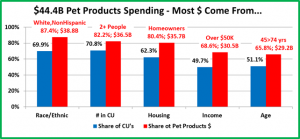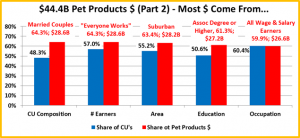2015 Pet Products Spending was $44.4B- Where does it come from?
The 2015 Consumer Expenditure Survey conducted by the US BLS with “field” work by the Census Bureau determined that Total Pet Spending in the U.S. reached $67.75B, a $3.43B (5.3%) increase over 2014. Pet Products (Pets, Food & Supplies) generated $44.39B, 65.5% of the total and 97% of the increase. Specifically, annual Pet Products spending increased by $3.32B (+8.1%). This came from a huge $5.43B (22.5%) increase in Food spending which overcame a $2.1B drop in Supplies. In earlier analyses we determined that the increase was primarily driven by the Baby Boomers, who elected to upgrade their Pet Food in 2015. However, that’s not the whole $44.4B Pet Products story.
Where did the bulk of the spending come from? In this report we will look at Pet Products Spending in terms of 10 demographic categories. The goal is to determine what groups are responsible for most of the overall spending. Our target number was to find demographic segments in each category that account for 60 to 80% of the total. In some cases this was easy – Homeowners. In other situations, we had to bundle individual segments together to reach our 60% “minimum”. Ex: Occupation – All Wage & Salary earners
Knowing the specific group within each demographic category that was responsible for generating the bulk of Pet Products Spending is a first step in a targeted marketing program. In part 2 of this 3 part report we will drill deeper to show the best and worst performing demographic segments for 2015! But first… Let’s “show you the money!”
In the 2 charts that follow, the demographic groups appear in ranked order by Total Pet Product market share from highest to lowest. I also included their share of total CU’s (Financially Independent Consumer Units). This allows us to see how each performed versus the size of the demographic group.
1. Race/Ethnic – White, Non-Hispanics (87.4%) The vast majority of Pet Products Spending is done by this group. In fact, Hispanics, African Americans and Asians account for 30% of CU’s but less than 13% of Pet Products Spending. The Hispanic portion of the U.S. population is growing strongly. This situation that was addressed in a recent report specifically covering racial/ethnic spending.. (Performance Rating: 125%)
2. # in CU – 2+People (82.2%) – It just takes two. More singles are adding Pets to their household. However, if you put 2 people together pets very likely will follow. (Performance Rating: 116%)
3. Housing – Homeowners (80.4%) Controlling your “own space” has long been the key to larger pet families and especially more pet products spending. (Performance Rating: 129%)
4. Income – Over $50K (68.6%) Although Pet Parenting is common in all income groups, money does matter. The top half of CU’s by income spent 69% of Pet Products $. (Performance Rating: 138%)
5. Age – 45>74 (65.8%) Income starts high with this group then fades. The key factor is that their children are older and in most cases have left home. When this happens, their attention and spending naturally turn to their Pet Children. (Also, All the Boomers are in this group) (Performance Rating: 129%)
6. CU Composition – Married Couples (64.3%) With or without children, two people, committed to each other, is an ideal situation for Pet Parenting. (Performance Rating: 133%)
7. # Earners – “Everyone Works” (64.3%) This is a composite of CU’s, regardless of size, where all adults are employed. While this group makes and spends more money, retired folks and CU’s with 2+ people and only one earner are still a significant share of Pet Products spending. (Performance Rating: 113%)
8. Area – Suburban (63.4%) Homeownership is high plus this group also has the “space” for pets. This equation invariably equals increased Pet Products Spending. (Performance Rating: 115%)
9. Education – Associates Degree or Higher (61.3%) All education levels certainly have pets but spending is another matter. Pet Products spending increases with education level. Consumers with a formal degree beyond a high school diploma accounted for 61% of spending. (Performance Rating: 121%) By the way, those with a degree or at least some college courses were responsible for 81% of Pet Products Spending.
10. Occupation – All Wage & Salary Earners (59.9%) – Pet ownership is widespread across this group. All individual segments had a performance rating of over 80% for Pet Products. (Performance Rating: 99%)
Overview: The Demographics of Pet Products spending are slightly different from those of Total Pet Spending, which includes the Services and Veterinary segments. The Pet Service segment is largely discretionary spending and inflation has become so strong in the Veterinary Segment that it has caused many price conscious consumers to delay, eliminate or look for alternatives for many Veterinary Clinic Services. In 2015, consumers also reduced their spending on Pet Supplies, but at the same time, some also radically increased Food spending by upgrading to a higher quality. If you are a Pet Parent, you can shop for value and exercise discretion in your purchases, but ultimately you have no choice. You must spend money on Pet Products.
Comments: In terms of this report, the spending disparity in regard to Race/Ethnicity is very evident. Putting 2 people together is definitely a “good bet for pet”. The correlation between homeownership (especially with a yard) and pet spending has been true from the earliest days of the industry. Yes, income does matter, especially with the current movement to upgrade Pet Food. but how you make the money isn’t as important. Educated consumers are also more likely to spend more. They usually make more money but they may also respond better to situations like the value of higher quality nutrition – even though it comes at a significantly higher price. Finally, as parents grow older and their children start to leave home, they turn their attention and spending to their Pet Children.
Pets are an integral part of the American way of life…but there is still room for the relationship to grow.
In Part 2 we will look at the Demographic Segment “Winners and Losers”





